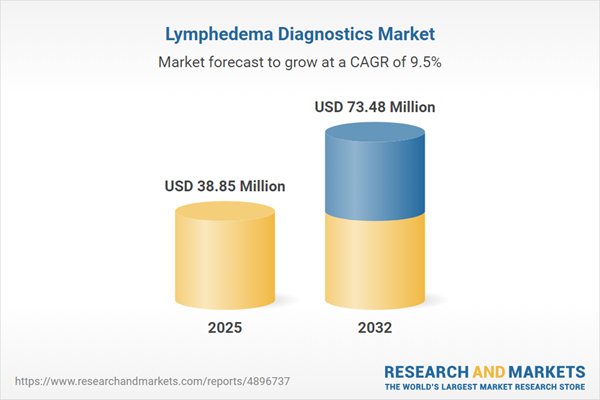Speak directly to the analyst to clarify any post sales queries you may have.
The lymphedema diagnostics market is evolving in response to healthcare’s demand for advanced, scalable solutions that improve clinical outcomes and align with dynamic regulatory standards. Senior leaders evaluating investments in this sector must weigh innovative technologies, operational adaptability, and shifting reimbursement landscapes.
Lymphedema Diagnostics Market Snapshot and Outlook
In 2024, the global lymphedema diagnostics market achieved a valuation of USD 35.46 million, fueled by continued investment in cutting-edge diagnostic technologies and upgraded healthcare infrastructure. Projections indicate sustained growth, with the market anticipated to reach USD 38.85 million in 2025, representing a compound annual growth rate (CAGR) of 9.53%. By 2032, the market size is forecast to reach USD 73.48 million, underscoring broader use of lymphedema diagnostics across different healthcare settings and a growing appetite for advanced capabilities. Enhanced diagnostic testing is enabling providers to establish standardized workflows, while variations in regional policies and reimbursement models continue to shape competitive dynamics for both established and emerging participants.
Lymphedema Diagnostics Market: Scope & Segmentation
- Application: Diagnostic tools cover both primary lymphedema (congenital and idiopathic) and secondary cases resulting from conditions such as cancer, surgical recovery, or trauma, enabling organizations to tailor solutions to diverse patient groups.
- Distribution Channel: Solutions are available as on-site deployments or through digital platforms, supporting flexible integration within hospitals and expanding reach via telemedicine initiatives in broader regions.
- Product Type: Available options span portable diagnostic devices, advanced imaging systems, assays using biomarkers, contrast media, and analytics software, each facilitating improved services in hospitals, research labs, and outpatient clinics.
- End User: Key stakeholders include hospital networks, independent diagnostic centers, and research institutions, all seeking integrated diagnostics to streamline workflows and coordinate patient health data effectively.
- Technology: Leading diagnostic modalities include bioimpedance spectroscopy, lymphoscintigraphy, SPECT, MRI, ultrasound, and optical imaging, promoting earlier, more accurate detection and supporting collaborative care models.
- Geography: Market activity spans the Americas, Europe, Asia-Pacific, and Middle East & Africa, where regional regulations and reimbursement conditions significantly inform technology adoption and strategic planning for stakeholders.
- Company Analysis: Leading industry figures—such as General Electric Company, Siemens Healthineers AG, Koninklijke Philips N.V., Stryker Corporation, and ImpediMed Limited—drive direction, while niche innovators pursue new product introductions and alternative distribution routes to generate differentiation.
Key Takeaways for Decision-Makers
- Integrated diagnostic platforms encourage better collaboration across specialties and enhance operational efficiency within healthcare organizations.
- Adoption of portable and digital diagnostic solutions allows providers to increase accessibility, especially in remote and underserved locations, expanding the reach of care beyond centralized settings.
- Compliance with shifting regulatory and reimbursement requirements eases the path for technology adoption and supports scalable deployment strategies across healthcare networks.
- Collaboration among device manufacturers, technology partners, and care networks leads to best-practice development, fostering efficient knowledge exchange and building industry-wide expertise.
- Continual updates to clinical protocols, guided by real-world data, support organizations in aligning with evolving medical guidelines and maintaining high standards in diagnostics.
Tariff and Trade Policy Impact
Expected tariff reforms in 2025 may influence cost structures and logistics for lymphedema diagnostics suppliers. In anticipation, many organizations are localizing production near primary healthcare markets, expanding supplier relationships, and refining procurement mechanisms. Efforts to strengthen ties with payers and implement robust data validation are also enhancing supply chain stability and streamlining reimbursement.
Methodology & Data Sources
This assessment draws from clinician and executive interviews, peer-reviewed literature, and relevant regulatory documents. The methodology provides targeted, actionable information for senior healthcare decision-makers in the lymphedema diagnostics market.
Why This Report Matters
- Empowers executive teams to assess diagnostic technologies using actionable, market-based evaluation frameworks.
- Equips organizations to anticipate regulatory and trade shifts and respond proactively to potential disruptions.
- Highlights priority areas for innovation to ensure alignment between operational objectives and clinical advancements.
Conclusion
This report supports senior leaders in making informed choices, optimizing diagnostic strategies, and maintaining organizational agility as the lymphedema diagnostics market continues to develop.
Additional Product Information:
- Purchase of this report includes 1 year online access with quarterly updates.
- This report can be updated on request. Please contact our Customer Experience team using the Ask a Question widget on our website.
Table of Contents
3. Executive Summary
4. Market Overview
7. Cumulative Impact of Artificial Intelligence 2025
Companies Mentioned
The companies profiled in this Lymphedema Diagnostics market report include:- General Electric Company
- Siemens Healthineers AG
- Koninklijke Philips N.V.
- Stryker Corporation
- ImpediMed Limited
- Bodystat Limited
- InBody Co., Ltd.
- Fluoptics SA
- Pero-System GmbH
- Holtain Limited
Table Information
| Report Attribute | Details |
|---|---|
| No. of Pages | 190 |
| Published | October 2025 |
| Forecast Period | 2025 - 2032 |
| Estimated Market Value ( USD | $ 38.85 Million |
| Forecasted Market Value ( USD | $ 73.48 Million |
| Compound Annual Growth Rate | 9.5% |
| Regions Covered | Global |
| No. of Companies Mentioned | 11 |









